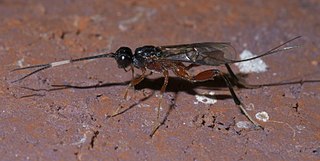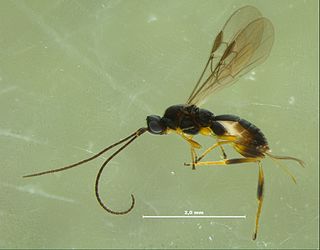
Microgastrinae is a subfamily of braconid wasps, encompassing almost 3,000 described species, with an estimated 30,000–50,000 total species. This makes it one of the richest subfamilies with the most species of parasitoid wasps.

Agathidinae is a subfamily of braconid parasitoid wasps. Some species have been used in biological control programs.

The Euphorinae are a large subfamily of Braconidae parasitoid wasps. Some species have been used for biological pest control. They are sister group to the Meteorinae.

Spathius is a genus of doryctine wasps. The larvae of this genus of wasps feed on beetle larvae. They act as biological controllers of the certain pest beetles, such as Hylurgopinus rufipes and the emerald ash borer.

The Rogadinae are a large subfamily of braconid parasitoid wasps. Several Rogadinae species parasitize pest caterpillars and are important for naturally occurring biological control.

The Cenocoeliinae are a subfamily of braconid parasitoid wasps.
Dirrhope is the only extant genus in the subfamily Dirrhopinae of braconid parasitoid wasps. Dirrope was included in the Microgastrinae until 1984. Specimens of this genus have been found fossilsed in amber dating from the Cretaceous period.

Brachistinae is a subfamily of braconid wasps in the family Braconidae.

Heterospilus is a genus of braconid wasps in the family Braconidae. There are at least 130 described species in Heterospilus.
Ivondrovia is a genus of parasitoid wasps belonging to the subfamily Doryctinae of the family Braconidae. This genus contains two species. It is found in the Afrotropical region.

Helconinae is a subfamily of braconid wasps in the family Braconidae.

Colastes is a genus of braconid wasps in the family Braconidae. There are at least 80 described species in Colastes.

Ondigus is a genus of braconid wasps in the family Braconidae. There are at least two described species in Ondigus, found in Mexico and Central America.

Heerz is a genus of braconid wasps in the family Braconidae. There are at least four described species in Heerz, found in Mexico and Central America.

Lissopsius is a genus of braconid wasps in the family Braconidae. There are at least three described species in Lissopsius, found in Mexico and Central America. They are generalist parasitoids of caterpillars.

Orgilus is a genus of insects belonging to the family Braconidae.
Hormius is a genus of parasitoid wasp in the subfamily Hormiinae first described by Christian Gottfried Daniel Nees von Esenbeck in 1818.















